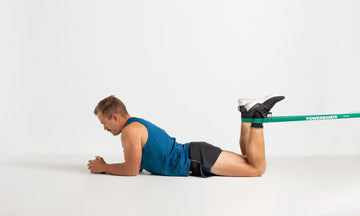When it comes to incorporating new things into your workout routine, the first thing you have to keep in mind is to create the setting. Whether or not you’re a young fitness enthusiast or a newbie, you’re bound to be caught up in the daily grind of school, work, deadlines, house chores, projects, social life, and more.
Because of these factors, you may find that going to the gym to try your newfound exercise could be challenging. Perhaps you want to try pull-up or achieve a certain number of pull-ups in a day.
If you really want to squeeze in a more advanced approach to working out, then it’s probably time to invest in resistance bands to help you with your band-assisted pull-ups. This way, you never have to worry about leaving your home or office space or think about expensive gym equipment ever again!
Moving forward, we’ll discuss a few essential bodyweight exercises that require grip/forearm, biceps, shoulder, scapular, and lat strength which can help you achieve your fitness goals. Read on to learn this brief workout guide to band-assisted pull-ups!
Improve Your Grip Strength
1. Passive and Active Hanging
The passive part is a good warm-up for your muscles. Meanwhile, the active part requires you to perform forty sets with brief intervals.
Improve Your Bicep Strength
1. The Barbell Curls
Strengthening your biceps through bicep curls is the gold standard for gym rats, despite it being built for them. Here, you must finish each curl at the brow level to allow the biceps to work from the shoulder attachment.
2. Extended Biceps Curl
This move is excellent for learning scapular retraction and introducing shoulder extension into your regimen. Furthermore, the resistance band you will use allows for free grip work.
3. Spider Curl
When performing this exercise, you begin in the starting position with weighted dumbbells that are right for your strength level. This slow and steady movement causes higher shoulder flexion and more efficient muscle results through time with a resisted momentum.
4. Face Pull
This workout strengthens the trapezius, rhomboids, and posterior deltoids while encouraging scapular retraction, which is beneficial for chin-up and pull-up variations.
Improve Your Lat Strength
1. Band Assisted Pull-Ups
The bandages require you to use the most at the bottom of your feet (where it provides the most resistance) for this movement.
2. Eccentric Chin-Ups
Hence, the name, this movement is not advised for newbies. Thus, you must perform this with extreme caution. Throughout the motion, keep a shoulder-to-ear distance.
3. Inverted Rows
This scalable action targets the lats instantly and can be adjusted based on your strength level. It is recommended to do 3 to 5 sets of 3 to 15 repetitions of most of these exercises 2 to 3 times a week.
Everything must be done with equal pushing volume, starting with the most significant muscles (lats) and moving down (lats, shoulders/scapula, biceps, forearms/grip). If you want to train more regularly, reduce the number of sets and repetitions, and vice versa.
The Daily Routine Sample
Following one or two weekly sessions, here's an example of a daily routine:
- 4 x 3 for Eccentric Chin-ups
- Pull-ups with Bands: 3x8-12 repetitions
- 3x15 reps for Face Pulls
- Three sets of 7 to 9 reps for Bicep Curls with a Fat Grip
Each week, increase the number of repetitions and the weight/resistance of the program to ensure growth. After that, commit to doing a pushing day to make sure your muscles aren't strained. This eventually leads to your first pull-up or chin-up.
The perfect chin-up starts with a passive to active hang, as shown in the video above. Do this by expanding our chests and raising our collarbones toward the bar. This engages the muscles of the middle and upper back and compresses the shoulder blades when done correctly. As a result, when performing chin-ups and pull-ups, we are less likely to have shoulder pain.
Draw your elbows toward the ground and the torso toward the bar to avoid flaring your ribs. At the peak of each rep, make contact with the bar with your chest. Then, reverse the movement to return to your passive hang position, squeezing your shoulder blades until your elbows are straight, before relaxing them.
Conclusion
With this brief guide, achieving your goals to perform band-assisted pull-ups could be effortless. At the same time, you’ll be improving the different muscle groups of your body, increasing your strength and agility. With consistency and discipline, you can make exercise challenges fun and fruitful!
If you’re looking for the best resistance bands, POWERBANDS® offer resistance band equipment that aims to meet your fitness goals. Shop our collections now and transform your life through movement!








